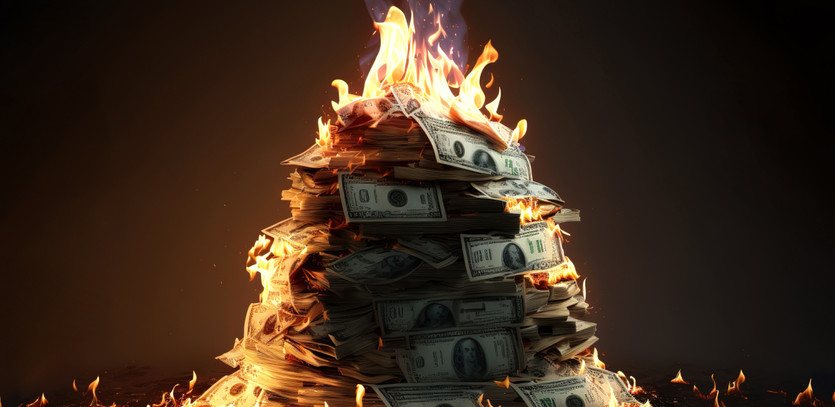Over several years, financial enthusiasts and investors alike have grappled with an intriguing question - Will the U.S. dollar collapse? This conjecture has become increasingly prominent due to shifts in the global economic landscape since the dawn of the 21st century, particularly with the emergence of China as an economic behemoth and the pondered diversification of oil trade beyond the U.S. dollar. Despite the allure of these considerations, the reality is that a monetary catastrophe in the United States seems rather improbable.
Understanding Currency Collapse: Unearthing the Why and How
Unraveling the Mysteries of Currency Collapse
Understanding the complexities of a currency collapse is critical in appreciating the sturdiness of the U.S. dollar. At its heart, a currency collapse is the swift and sharp depreciation of a country's legal tender against other currencies.
Currency collapses are usually symptomatic of deeper economic crises. They precipitate when the public's belief in the currency as a store of value or medium of exchange disintegrates. There's often more than meets the eye when a currency is on the brink of collapse, and a multitude of intertwined factors can contribute to such a catastrophic economic event.
These factors generally include:
-
Incorrect Currency Valuations: This situation arises when a nation's central bank artificially manipulates the exchange rate, making the local currency appear stronger on the international stage than warranted by the fundamentals of the economy.
-
Pegging of the Currency: Pegging is a policy where a country's currency is set at a fixed exchange rate to another, usually stronger, currency. Although pegging can help stabilize a weak currency, it becomes problematic if the peg is maintained at an unsustainable level.
-
Extended Phases of National Economic Stagnation: Stagnation or contraction of a country's economy over an extended period erodes international confidence in its currency, resulting in a potential collapse.
-
Hyperinflation: A period of very high and typically accelerating inflation erodes the real value of the local currency, as the prices of all goods increase. This creates a situation where the currency, though still accepted, remains distrustfully regarded.
Unpacking the Resilience of the U.S. Dollar
At the heart of the U.S. dollar's stability is its persistent demand, driven by the U.S.'s economic and political stability. As the world's largest economy, many nations rely on the U.S. dollar for international trade and as a hedge against local economic volatility.
This steadfast demand is only enhanced by the dollar's unique status as the world's principal reserve currency. An overwhelming majority of international transactions are conducted in dollars, and a large portion of the world's wealth is held in U.S. dollars.
Such a significant entrenchment of the U.S. dollar in global financial systems means that a collapse would have devastating effects worldwide, creating a vested interest among nations in maintaining the dollar's stability. Consequently, the probability of a U.S. dollar collapse is, by most practical considerations, approaching zero.
A Look Back: Historical Instances of Currency Collapse
History as a Harbinger of Lessons
Throughout the past century, history has seen its share of abrupt and devastating currency collapses. Understanding these historical instances provides a prism to grasp the intricacies of economic catastrophes and how they can be avoided.
A few examples include:
-
Argentina: This South American nation has been notorious for economic instability. Its most recent collapse in 2001 was due to a combination of heavy borrowing, fiscal mismanagement, and a rigid currency peg to the U.S. dollar.
-
Zimbabwe: At the turn of the century, Zimbabwe suffered from one of the worst cases of hyperinflation in history, which ultimately led to a complete abandonment of its currency in 2009.
-
Germany (Weimar Republic): Post-WWI Germany experienced hyperinflation due to the burden of reparations, leading to the famous image of wheelbarrows full of cash being required to buy everyday goods.
-
Russia: In 2014, Russia faced a significant depreciation of the Ruble because of declining oil prices and international sanctions.
Such occurrences underline the fragile relationship between economic policy, global politics, and currency value. A misstep in managing these aspects can lead to the disintegration of a currency's value, causing widespread socio-economic hardship.
The Backbone of the U.S. Dollar: Exploring its Strengths
The Dominance of the Dollar: An Unquestionable Global Reserve Currency
A pivotal factor bolstering the U.S. dollar's strength is its global reserve currency status. Being the primary reserve currency, the U.S. dollar holds an unrivaled place in international finance.
Governments and central banks around the globe hold large reserves of U.S. dollars to back their own currencies, fostering additional faith in the U.S. dollar's stability. This faith extends to domestic users, international currency traders, and participants in international transactions.
Moreover, global oil transactions, denoted as petrodollars, are mostly conducted in U.S. dollars. This practice adds a significant demand for the dollar on the international stage and further cements its dominance.
The Strength of American Economy: A Key Pillar of Support
Underpinning the dominance of the U.S. dollar is the strength and size of the American economy. The U.S. boasts the largest and one of the most dynamic economies in the world. Despite some economic slowdown since 2001, the U.S. often outperforms its peers in Europe and Japan.
This economic might is backed by the productivity of American workers, reinforcing the value of the U.S. dollar as long as these workers continue to use the dollar almost exclusively.
Competitors as a Safety Net: Diversifying the Pool of Reserve Currencies
While the U.S. dollar enjoys unparalleled dominance, it isn't the only reserve currency in the world. The International Monetary Fund (IMF) acknowledges other currencies such as the euro, British pound sterling, Japanese yen, and the Chinese yuan as reserve currencies.
Having other currencies as potential alternatives adds a layer of safety for global economies. It also acts as a deterrent against any harmful monetary policies by the U.S., as the rest of the world has alternatives at their disposal.
Each of these elements contributes to the U.S. dollar's robustness, solidifying its position in the world economy and making the prospect of its collapse increasingly remote.
Recognizing the U.S. Dollar's Vulnerabilities: Where It Might Falter
The Double-Edged Sword of Fiat Money
The foremost vulnerability of the U.S. dollar, akin to other major currencies, stems from its nature as a fiat currency. Fiat currencies derive their value not from a physical commodity but from the trust and confidence of their users and the backing of their governments. In essence, the dollar is valuable because the government says it is and because its users believe in its value.
This system, despite being universally adopted, was not long ago viewed as a radical proposal. Until the early 1970s, the U.S. dollar was backed by gold reserves, a tangible asset. The shift to a fiat system raised concerns that governments could overuse their ability to print money for political gains or war efforts, potentially leading to a currency's devaluation.
The Risk of Overextending: Inflation and Debt
A related risk lies in the potential for high inflation and debt. If the Federal Reserve creates money and the U.S. government incurs and monetizes debt faster than the growth rate of the economy, it could lead to the devaluation of the dollar. If foreign investors or governments decided to move away from the U.S. dollar en masse, this could spell trouble for the currency and anyone with dollar-denominated assets.
Pondering the Collapse of the U.S. Dollar: Plausible Scenarios
Navigating Through Stormy Waters: The Threat of High Inflation and High Debt
The most plausible scenario that could trigger a crisis for the U.S. dollar involves the twin threats of high inflation and high debt. In this context, if consumer prices begin to rise significantly, it could force the Federal Reserve to sharply raise interest rates. Given that a large chunk of national debt consists of short-term instruments, a spike in rates could lead to a situation akin to an adjustable-rate mortgage after the teaser period ends.
Under such circumstances, if the U.S. government struggled to afford its interest payments, foreign creditors could sell off their dollar holdings, potentially triggering a collapse.
The Isolated Recession: A Domestic Downturn
An alternate scenario could be an economic downturn solely within the U.S., without dragging the rest of the world along with it. In such an event, there might be a shift away from the U.S. dollar, with global investors seeking refuge in more stable currencies.
The Rise of a New Reserve Currency: An Unlikely But Possible Scenario
A highly theoretical scenario would involve another major power, like China or a post-European Union Germany, reinstating a commodity-based standard and managing to monopolize the reserve currency space. While these scenarios seem less probable, their occurrence would undoubtedly put the U.S. dollar's supremacy to the test.
The Aftermath of a U.S. Dollar Collapse: Hypothetical Impact
Inflation Surge and Economic Downturn
In the hypothetical scenario of a U.S. dollar collapse, the implications would be far-reaching and severe. One immediate consequence would be a substantial increase in the cost of imports. With a weakened dollar, the price tag on goods from abroad would skyrocket, translating to heightened living costs for the average American.
Moreover, a collapsing dollar would make borrowing more expensive for the government. The deficit created by the inability to borrow at current rates would need to be filled either by escalating taxes or resorting to money printing. In either case, these measures would only fuel inflation further, potentially leading to an overall economic meltdown.
Protecting Your Financial Future: The Dollar Collapse and Your 401(k)
Preparing for a Potential Currency Storm
A collapsing dollar would directly hit your 401(k) retirement savings. Inflation, a natural consequence of a currency's collapse, would decrease the real value of the dollar when compared to other global currencies. This would, in effect, diminish the value of your 401(k).
In a worst-case scenario, your retirement savings could lose such significant value that they may end up becoming virtually worthless. This highlights the importance of adopting strategic measures to protect and diversify your investments.
Safeguarding Against a Potential Dollar Collapse: Proactive Measures
Diversifying Investments: The Key to Protection
Despite the unlikelihood of a U.S. dollar collapse, adopting a proactive stance can serve as a safeguard. The most effective means to hedge against such an event is by diversifying your investment portfolio.
- Investing in foreign currencies: Purchasing currencies of economically strong and stable countries is a sound strategy.
- Opting for international funds: Investing in mutual funds and ETFs based in other nations can provide added security.
- Buying shares of multinational corporations: Acquiring shares of domestic companies with substantial international operations offers another level of protection.
By diversifying your investments, you spread the risk and can protect yourself from the potential downfall of a single currency.
Concluding Thoughts: The U.S. Dollar Stands Firm
Despite potential vulnerabilities and theoretical scenarios of collapse, the commercial viability of the U.S. remains robust. The U.S. dollar continues to reign as a global currency in international transactions, with the majority of oil trades conducted in dollars. Moreover, the U.S. is the world's largest economy and is recognized as a politically and economically stable nation.
Therefore, it is reasonable to conclude that, while there may be fluctuations and challenges, there is no imminent threat to the U.S. dollar's standing as a global reserve currency. Its collapse, while theoretically possible, remains highly unlikely in the foreseeable future.





